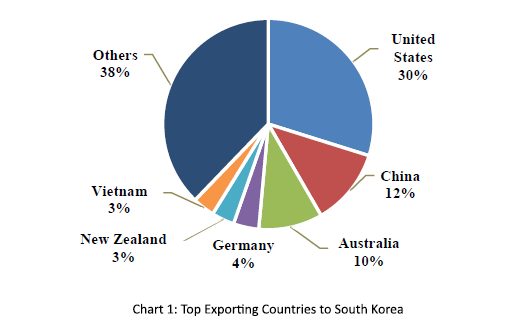
Market Information > Market Overview
Market Overview
Executive Summary
The Republic of Korea (ROK) had the 12th largest economy in the world with a GDP of $1.87 trillion and a per capita GNI of $36,624 in 2024. It is about the size of Indiana, with a population of 51.8 million. Over 80 percent of Koreans live in urban areas. Domestic production meets only 46 percent of food demand. The United States exported $8.9 billion in agricultural and related products to the ROK in 2024, making it our fifth largest country export market. The United States supplies around 21 percent of the ROK's agricultural imports.
Consumer-Oriented Agricultural Imports
In 2024, the ROK imported consumer-oriented agricultural products totaling around $20.6 billion. There are many opportunities for U.S. export growth in this segment, including for beef, pork, fruits, tree nuts, dairy products, confectioneries, beverages, and further prepared foods.

Food Processing Industry
In 2023, Korea had over 31,075 food processing companies, which generated $65.0 billion in sales. Korean food processing companies rely heavily on imported commodities and ingredients. Imports of basic and intermediate agricultural products totaled $16.9 billion in 2024. Eighteen percent ($3.2 billion) of these imports came from the United States.
Food Retail Industry
Korean retail food sales totaled $132 billion in 2024, accounting for 31 percent of total retail sales (excluding automobiles). Among grocery retailers except e-commerce, convenience stores were the leading retail channel, followed by grocery supermarkets, hypermarket discount stores, and warehouse clubs.
Food Service Industry
The Korean HRI sector reached $147 billion in 2023 (the latest official data available), an 8.3% increase from the previous year. The industry faced challenges due to economic uncertainties and weakening consumer confidence in 2024. However, industry is expected to see gradual growth as businesses evolve to meet growing consumer demand for convenience and new experiences.
Quick Facts CY 2024
Imports of Consumer-Oriented Products
US $20.6 billion ($6.1 billion from the United States)*
Top 10 Import Growth (%) Products in the ROK, by value (BICO, 2023-2024)
Food Industry by Channels ($U.S. billion)
Top 10 Korean Retailers
Coupang LLC, Shinsegae Co Ltd, Naver Corp, Lotte Group, GS Holdings Corp, SK Telecom Co. Ltd, Hyundai Department Store, BGF Retail Co Ltd, Alphabet Inc, Homeplus Co. Ltd.
GDP/Population (2024)
Population: 51.8 million
GDP: US $1.87 trillion
GDP per capita: US$ 36,113
Strengths/Weaknesses/Opportunities/Threats
| Strengths | Weaknesses |
|---|---|
| Well established market with modern distribution channels | High logistics costs to ship American products |
| Consumer income level continues to increase | Complex import regulations including food safety and labeling standards |
| Opportunities | Threats |
|---|---|
| Strong consumer demand for value, quality, and variety | Elevated competition from export-oriented competitors |
| KORUS FTA reduces tariff barriers for American products. | Discrepancies in food safety and labeling regulations |
Data and Information Sources:
Latest available statistics are used in this publication and will continue to be updated throughout the year as new data is available. Global Agricultural Trade System (GATS), Korea Ministry of Food & Drug Safety, Korea National Statistics Office, CIA Factbook, Int’l Monetary Fund (IMF), Korea Int'l Trade Association, Euromonitor Int’l.
Contact: U.S. Agricultural Trade Office Seoul
E-mail: atoseoul@usda.gov
For more detailed information about the Korean market see the Exporter Guide 2025.
Agricultural Trade Office, U.S. Embassy - Seoul
Tel: 82-2-6951-6848 Fax: 82-2-720-7921
Email: atoseoul@usda.gov